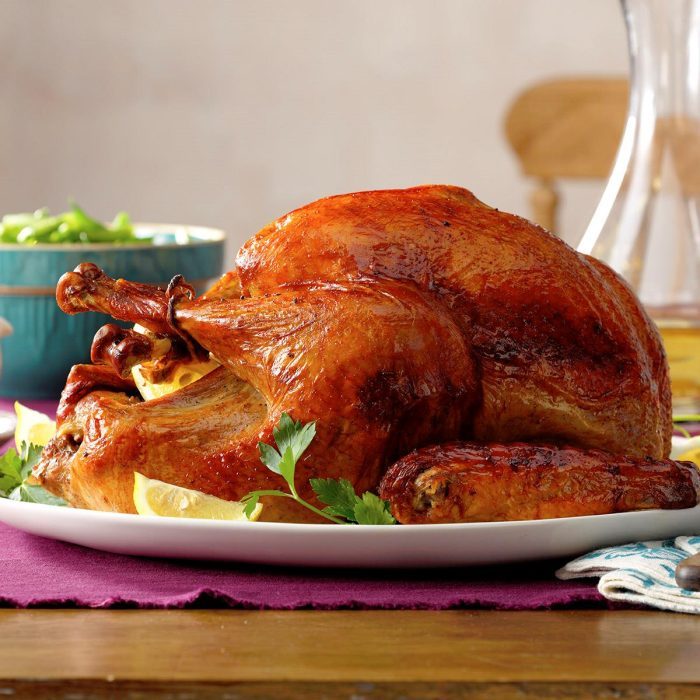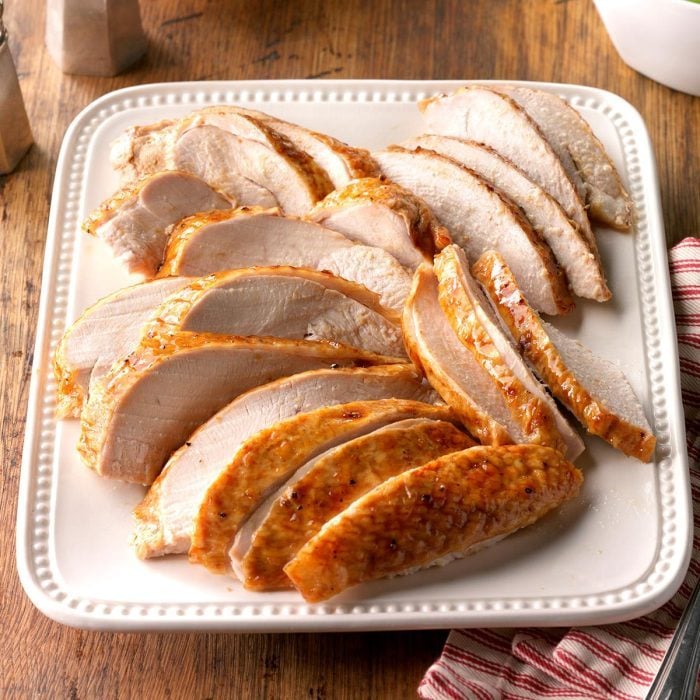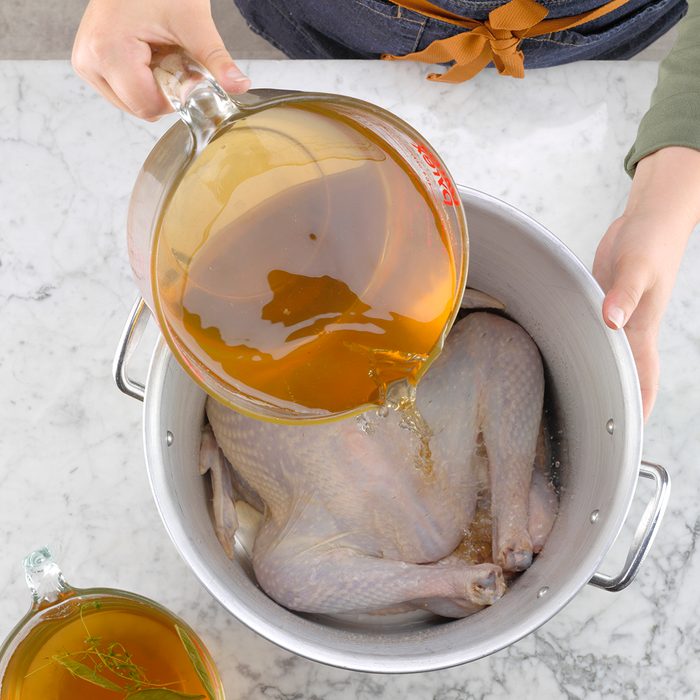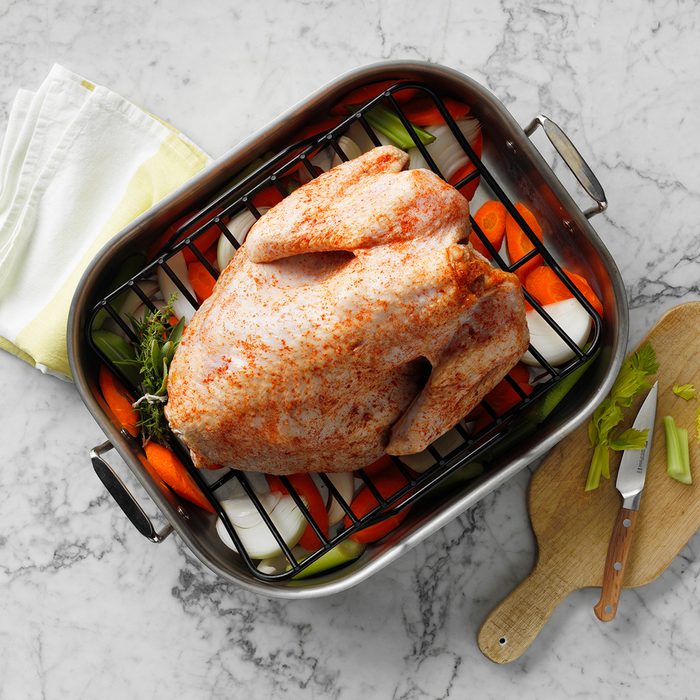Make your Thanksgiving turkey more flavorful than ever with our top turkey tips. In no time, youll know how to season a turkey that guests will crave.
With Thanksgiving just around the corner, you’re sure to have your menu planned from the best Thanksgiving sides to perfect pumpkin pies. And of course, you’ve got the traditional turkey lined up.
Whether you’re serving up a small gathering of close friends and family, or throwing a Friendsgiving get-together, you’ll want to get (and serve) the perfect turkey for everyone at the dinner table. Make sure you know how much turkey to serve per person, so you grab the right size bird for your holiday dinner.
But before you pop your perfectly chosen turkey into the oven, don’t forget to season it well. The right Thanksgiving turkey recipes paired with pitch-perfect seasoning can turn your turkey from a basic bird to a fantastic fowl. Follow these tips and tricks on seasoning your turkey for a juicy and flavorful meal.
The Thanksgiving turkey is the star of the show, but let’s be honest – it often ends up dry and bland. This year, make your bird shine by amping up the flavor with these easy techniques.
Start With a Quality Turkey
The foundation of delicious turkey is sourcing a high-quality bird Opt for free-range, organic, or heritage breeds for more moisture and flavor. Standard supermarket turkeys are mass-produced for maximum size and white meat Specialty turkeys have a more balanced profile.
Try a Compound Butter Under the Skin
Slathering butter under the skin helps keep the turkey moist and crisp. For even more flavor, make a compound butter by mixing herbs, citrus, honey, or garlic into soft butter. Gently loosen the skin from the breast and spread the flavored butter directly onto the meat before roasting.
Stuff the Cavity with Aromatics
Fill the inside cavity with lemon wedges, fresh herbs like thyme and sage, whole garlic cloves, chopped onion, and peppercorns. As the turkey roasts, the heat releases the aromas into the meat.
Brine for Added Moisture and Seasoning
Soaking the turkey in a saltwater brine before cooking infuses moisture and seasoning. Make a basic brine with water, salt, sugar, and spices Let the turkey soak for 12-24 hours. Rinse and pat dry before roasting
Give it a Spice Rub
Coat the skin with a blend of dried spices like cumin, paprika, coriander, thyme, and brown sugar. The rub adds tons of flavor as the turkey cooks Apply it directly onto the skin or mix it with olive oil or butter first to help it adhere.
Sauté Aromatics to Stuff Under the Skin
Sauté onion, celery, apples, and herbs in butter or olive oil. Let cool and carefully loosen the breast skin to stuff the mixture directly onto the breast meat before roasting.
Use Your Grill for Smoky Flavor
Get bonus flavor by grilling the turkey over indirect heat. Start with a hot grill to sear the skin and finish roasting over medium heat, adding hardwood chips for smoky flavor.
Transform the Drippings into Gravy
Don’t throw out the flavorful pan drippings and browned bits after roasting! Transform them into the most delicious gravy by simmering with chicken or turkey stock and thickening with a roux.
Glaze It Up
Brush on a sweet, savory, or spicy glaze during the last 30 minutes of roasting. Try maple syrup, citrus juice, mustard, or soy sauce mixed with garlic, herbs, spices, or jam. The glaze adds flavor and helps crisp the skin.
Infuse the Bird with Herbs
Chop fresh herbs like rosemary, thyme, oregano, or sage and gently slide them under the skin before roasting. As the turkey cooks, the herbs release aroma and flavor into the meat.
Slather with Flavored Mayo or Oil
Coat the skin with an herbed mayonnaise or olive oil before roasting. The coating helps crisp the skin while adding flavor. Try mixing garlic, rosemary, thyme, lemon zest, or chipotle powder into the mayo.
Bacon-Wrap Those Legs and Wings
Nothing says flavor like bacon! Wrap strips of bacon around the turkey legs and wings to infuse smoky, salty flavor as it cooks.
Break Out the Butter Baster
Baste the turkey every 30 minutes while roasting by dipping a bulb baster into melted butter or broth. Drizzle the hot liquid over the bird to add flavor and moisture.
Let It Rest Before Carving
Never slice into turkey right away! Letting it rest for 20-30 minutes allows juices to reabsorb for moister meat. Use this time to make gravy with the drippings.
With these quick tricks, your turkey will be overflowing with finger-licking flavor. Now dig in and enjoy the star of your Thanksgiving meal!
:max_bytes(150000):strip_icc()/23037-easy-beginners-turkey-with-stuffing-vat-02-4X3-a851b00227654beb8a1c376b5b532115.jpg)
Coat with Flavored Butter
When hasn’t butter made something better? Rub flavored butter underneath the skin of your turkey to add another layer of flavor to your traditional turkey while also crisping up the skin.
This is really an easy way to add flavor to your main course, so for those hosting a Thanksgiving dinner, don’t be afraid to try this technique.

Marinades aren’t just for the grill! Try marinading your turkey in a mixture of broth, spices, and lemon juice, like in our Marinaded Thanksgiving Turkey for a roast that’s flavorful through and through.
Similar to brining, your turkey should sit in the marinade for a few hours to soak up all the delicious flavors.

Layer on the flavor with a bright and aromatic glaze. Brushing on a glaze takes an already tasty turkey skin to the next level. Glazes are an easy and quick way to give your main course an extra boost.
You can make an apricot-glazed turkey with just four ingredients.

Season Under the Skin
It can be tempting to sprinkle your seasonings right on top of the frozen turkey (obviously after defrosting it) as you’d do with any other protein. To get the most flavor, however, it’s best to season under the skin. This is our greatest tip for teaching anyone how to season a turkey.
This puts those spices in direct contact with the meat for maximum impact. Plus, if you don’t like the skin you can peel it off after cooking without losing all the herby goodness.
When it comes to seasoning, salt and pepper are the right place to start. But you can expand upon these basics by using fall herbs like rosemary, thyme, and sage, which are natural accompaniments for turkey. You can branch out further with your favorite seasoning blends.

To add extra flavor and tenderness to your Thanksgiving turkey, try a basic brine or you could even go for a dry brine. Soaking the turkey in this saltwater mixture helps to tenderize the meat while adding flavor and moisture throughout the entire turkey. The simplest of brines is plain ol’ saltwater, but we love to add herbs and spices to give the turkey as much flavor as possible. These turkey brine recipes will give you the inspiration you need.
But take heed, brining is a plan-ahead trick. Your bird should sit in the brine for at least four hours (though overnight is best, so start a full day ahead). And before you brine, make sure you have a food-safe container large enough to accommodate your bird.

You’ll Never Go Back To Your Old Turkey Method After This
FAQ
How to enhance the flavor of turkey?
How do you make turkey not taste bland?
What should I put inside turkey for flavoring?
What can I add to ground turkey to make it taste better?
How do you add flavor to a Turkey?
Never pass up the opportunity to add flavor to turkey by stuffing the cavity with a simple aromatics mix. Fresh herbs like thyme, rosemary, and sage along with a half lemon go a long way to add flavor, and stuffing it into the bird takes almost no time at all. (While you’re at it, season the cavity with a good amount of salt and pepper.)
How can I get my taste back during a cold?
When a person gets cold, there are many clinical symptoms with fever, nausea, fatigue and loss of appetite etc. Once cold has gone, all the symptoms will disappear immediately with taste back.
How do you make a roasted turkey taste good?
Baste or glaze away. Basting a bird with its own pan juices (or butter that has pooled in the bottom of the roasting pan) can make for golden brown skin that tastes great too. Try Ree’s method of basting the turkey toward the end of roasting rather than basting throughout the entire cook time.
How do you add flavor to a bird?
Another simple, easy way to add flavor to a bird is by stuffing the cavity or roasting pan full of aromatics. Think fresh herbs (rosemary, thyme, sage, or oregano), onion, shallots, garlic, and citrus halves. They’ll gently perfume the meat and pan drippings with flavor.
